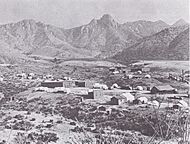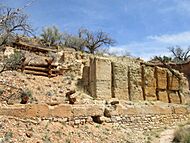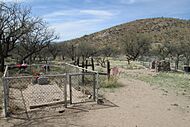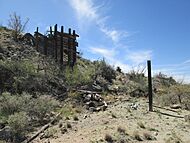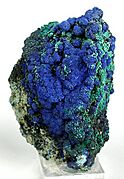Helvetia, Arizona facts for kids
Quick facts for kids
Helvetia, Arizona
|
|
|---|---|
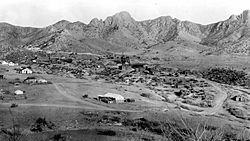
Helvetia in 1909, facing east.
|
|
| Country | United States |
| State | Arizona |
| County | Pima |
| Founded | 1891 |
| Abandoned | 1921 |
| Elevation | 4,324 ft (1,318 m) |
| Time zone | UTC-7 (MST (no DST)) |
| Post Office opened | December 12, 1899 |
| Post Office closed | December 31, 1921 |
Helvetia is a ghost town in Pima County, Arizona. A ghost town is a place where people once lived and worked, but now it's mostly empty. Helvetia was settled in 1891 and became empty in the early 1920s. The name Helvetia is an old name for Switzerland.
Today, you can only visit the Ray Mine and the cemetery. The rest of the town is fenced off because mining is still happening there.
Contents
A Look Back at Helvetia's History
The Santa Rita Mountains in Arizona have been a place for mining for a very long time. People mined there when the area was part of the Spanish Empire. Even after it became part of the United States in 1854, mining continued. At first, people mostly looked for silver or gold.
The Start of Copper Mining
Things changed in 1875. Two business partners from Tucson, Pinckney Tully and Estevan Ochoa, started mining for copper. They brought about 5,000 pounds of copper ore to Tucson to be melted down. This was one of the first times a lot of copper was taken from these mountains.
A few years later, in 1878, Ben Hefti and T.G. Roddick, along with others, created the Helvetia Mining District. This was a ten-square-mile area on the western side of the mountains. Hefti named it Helvetia because it was the old name for his home country, Switzerland.
In 1879, Roddick and James K. Brown made a mining claim called the Modoc. This was likely the first claim in the new district.
A Short Break in Mining
In 1883, a national economic problem made it too expensive to mine copper. Because of this, most mining in the Helvetia district stopped for almost ten years.
Helvetia's Boom and Bust
Mining started up again in the early 1890s. This was because more and more copper was needed for new electrical products like wires.
Paine Webber & Company, a big investment company, began working in the Helvetia Mining District. They tested the land and dug many shafts. The workers for this company soon formed the first small mining camp, which became Helvetia.
By 1899, Paine Webber & Co. started a new company called the Helvetia Copper Co. of New Jersey. This company was in charge of all the mining.
Many changes happened around this time. The number of workers grew from less than 55 to about 350 by the end of the year. The total population reached about 550 people. To help people get around, a road was built from Helvetia to the Vail train station. A stagecoach line also started, connecting the camp to Tucson.
A narrow-gauge railroad, which eventually became over 4 miles long, was built. This train carried copper ore from mines farther away to a new smelter in Helvetia. A smelter is a place where ore is heated to separate the metal. Soon after, Helvetia got its first school and a post office.
The town also had stores, like those run by Verdugo and Barcelo. Butchers sold meat to the miners, and there was a barbershop, a shoe repair shop, and a Chinese laundry.
Helvetia became the most important mining camp in Pima County around 1900. However, this success did not last long.
Challenges and Decline
Even though there was a lot of copper ore, Helvetia had a big problem: not enough water. Water was needed to keep the new smelter cool. Another issue was a shortage of coke, a special type of coal, which had to be brought in from the Vail station. Because of these problems, the company could not run the smelter all the time, and they lost money.
In 1901, the smelter burned down, stopping all operations for a year.
In 1905, a new company, the Helvetia Copper Co. of Arizona, took over. But they also struggled to make a profit.
A financial crisis in 1907 caused more problems for the mining camp. By 1911, the company closed down its operations. The camp stayed alive for a few more years, especially during World War I when copper was greatly needed. But by 1923, the school closed, and most people moved to other towns like Greaterville or Tucson.
The 1967 western movie Hombre was filmed in Helvetia.
Helvetia Today
There isn't much left of Helvetia to see now. You can find a few foundation walls and the ruins of the old smelter. The cemetery is also still there. Nearby, you can see piles of waste rock from the mines. Even though the town is mostly gone, some homes in the area are still used, including the Helvetia Ranch.
Where is Helvetia?
Helvetia is located in the Santa Rita Mountains, north of Madera Canyon. Its coordinates are 31°51′28″N 110°47′17″W / 31.85778°N 110.78806°W.
The Rosemont Project
The Rosemont project is a large copper deposit located nearby. A "deposit" is a place where a lot of valuable minerals are found. This area might become a new mine if it gets the right approvals. There is a big area of copper ore between Helvetia and another ghost town called Rosemont.
The Rosemont deposit has about 550 million tons of ore, with about 0.45% copper. It also has some molybdenum and silver.
In 2010, Augusta Resources owned the Rosemont project. They hoped to start mining as early as 2011. The Rosemont Copper plan aimed to create a modern mine in Southern Arizona. This plan included new ways to protect the environment, like saving water and storing waste materials safely. The Rosemont Copper project was expected to create over 2,900 jobs each year for Arizona and bring in more than $19 billion in economic activity.
Many local, state, and federal groups reviewed Rosemont Copper's plan. They would only give permission to operate once all environmental protections were in place.
Some local people are against building this mine. They worry about losing historic and ancient sites in the area, as well as natural habitats for plants and animals. As of 2023, mining operations have not yet started.
Gallery




